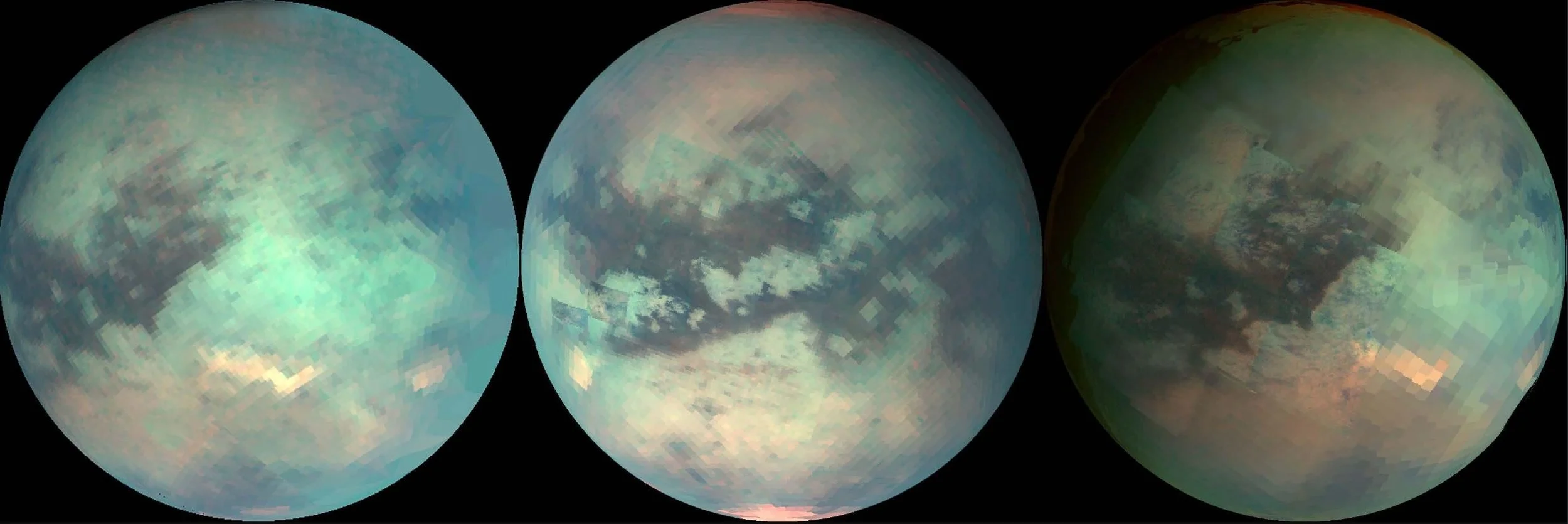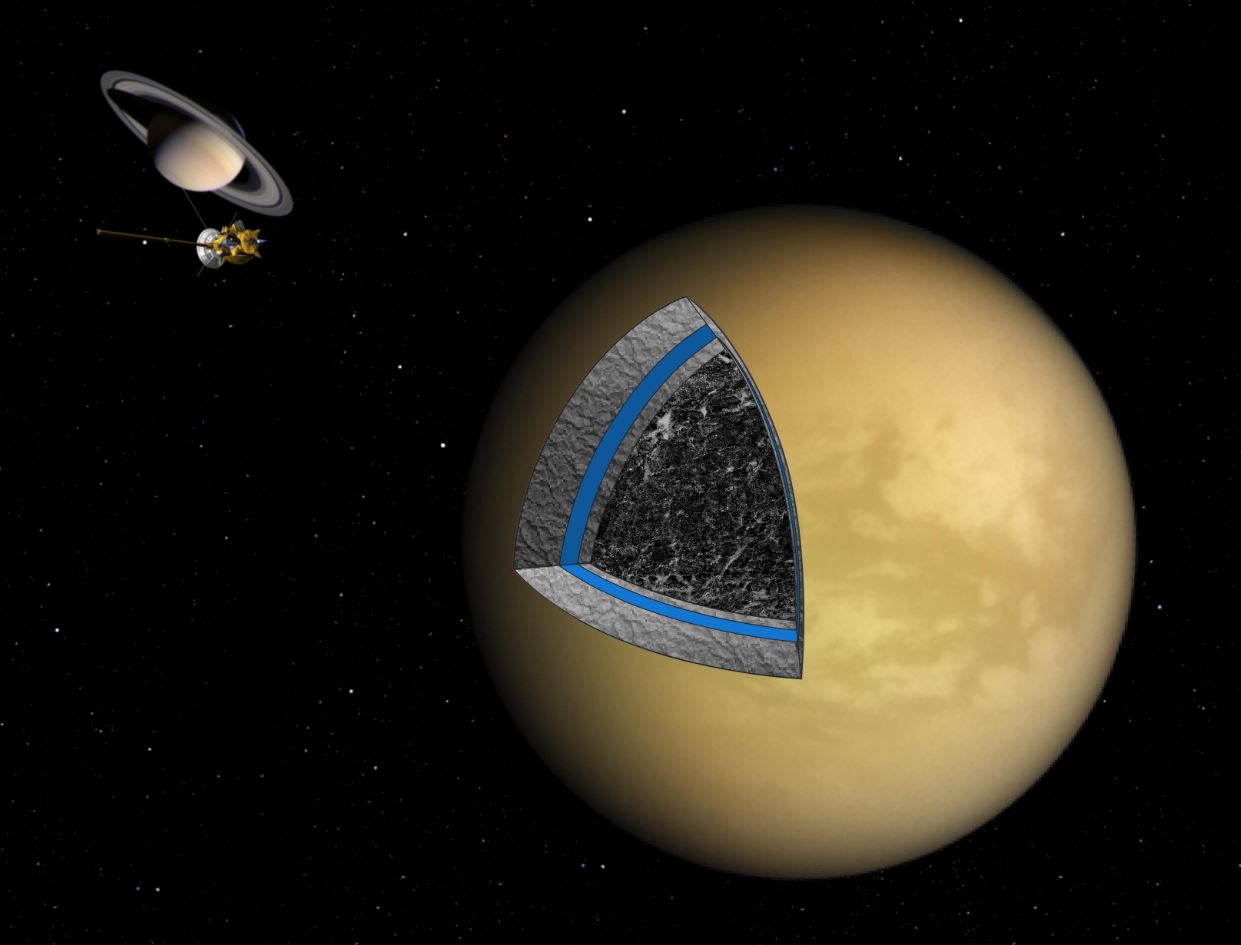Subject: Exploring Titan and finding out if it is potentially habitable - Comments and suggestions are welcome! Don't hesitate and leave a comment on our comment section down below the article!
By Fraser Cain
Image Credit: NASA via Wikimedia Commons
There are few places in the Solar System which are as fascinating as Saturn’s moon Titan. It’s a world with a thicker atmosphere than Earth. Where it’s so cold that it rains ammonia, forming lakes, rivers and seas. Where water ice forms mountains.
Like Europa and Encleadus, Titan could have an interior ocean of liquid water too, a place where there might be life.
Titan’s got layers, and fortunately, there’s an awesome new mission in the works to explore it: the Titan Dragonfly mission.
For the longest time, astronomers didn’t know how special Titan was. That’s because the Saturnian moon is cloaked in thick clouds that obscure a view to its surface. In fact, for the longest time, astronomers thought that Titan was the largest moon in the Solar System, since they couldn’t tell where the atmosphere ended and the ground started. Now we know that Ganymede is a little bigger.
The first spacecraft to visit Titan was Pioneer 11 in 1979. It couldn’t see through the thick clouds, and neither could the twin Voyager spacecraft, which followed in 1980 and 1981. They did gather some additional clues about Titan, though, detecting traces of hydrocarbons in the atmosphere, like acetylene, ethane, and propane. Most of its atmosphere, however, is nitrogen, just like Earth.
This view of Saturn’s largest moon, Titan, is among the last images the Cassini spacecraft sent to Earth before it plunged into the giant planet’s atmosphere. - Image Credits: NASA/JPL-Caltech/Space Science Institute
With an atmosphere filled with nitrogen, and containing hydrocarbons, this sounds like a potential spot to find life. Maybe even life that uses entirely an entirely different biology than Earth life.
How habitable is Titan?
It wasn’t until NASA’s Cassini spacecraft made the long journey to Saturn and went into orbit around the ringed planet in 2004 that the instruments were finally in place to peer through Titan’s cloaking atmosphere.
Over the course of its 13-year mission at Saturn, Cassini flew past Titan 127 times, using radar and infrared instruments to see through the haze and reveal features on the surface of Titan. Cassini saw clouds of hydrocarbons, which rain hydrocarbons into hydrocarbon rives, collecting into hydrocarbon lakes and seas. My point is… hydrocarbons.
The three mosaics shown here were composed with data from Cassini’s visual and infrared mapping spectrometer taken during the last three Titan flybys, on Oct. 28, 2005 (left image), Dec. 26, 2005 (middle image), and Jan. 15, 2006 (right image) - Image credits: NASA/JPL/University of Arizona
Cassini also dropped off the European Space Agency’s Huygens lander, which parachuted down through the atmosphere recording its entire two and a half hour journey. It landed on the surface and sent back the first ever images from the ground on Titan.
Between them, Cassini and Huygens revealed that Titan is covered with organic molecules, in the kind of state that was thought to exist here on Earth 4 billion years ago. The problem, of course, is that Titan is incredibly cold. That’s how you get all those liquid hydrocarbons I was going on and on about.
The surface temperature is -179 Celsius or -209 degrees Fahrenheit. Just for comparison, the coldest temperature ever recorded on Earth is about -92 Celcius or -133 Fahrenheit.
The thick nitrogen atmosphere on Titan means you wouldn’t need a spacesuit if you wanted to walk outside on Titan, just a really really thick coat.
So you’ve got all these raw materials for life on the surface, in a fairly thick nitrogen atmosphere, with liquid hydrocarbons acting like a solvent and swirling chemicals around. There’s even ultraviolet radiation from the Sun breaking up chemicals, and encouraging new chemical reactions with hydrogen, methane and nitrogen
Ligeia Mare, shown in here in data obtained by NASA’s Cassini spacecraft, is the second largest known body of liquid on Saturn’s moon Titan. It is filled with liquid hydrocarbons, such as ethane and methane, and is one of the many seas and lakes that bejewel Titan’s north polar region - Image Credits: NASA/JPL-Caltech/ASI/Cornell
But then you’ve got a brutally cold environment, completely hostile to life on the surface.
The good news is that Titan seems to have a liquid ocean beneath its icy surface: just like Jupiter’s Europa and Saturn’s Enceladus. This was confirmed by careful gravity measurements made by Cassini during its 137 flybys.
The difference is that Titan has all the building blocks of life on the surface layer, surrounding the ocean. See how this is ideal?
At NASA’s Jet Propulsion laboratory, a group of scientists is trying to figure out how likely it might be for there to be life in Titan’s oceans. Between now and 2023, they’re hoping to work out the conditions that could allow organic molecules to move from the surface of the world, down into its interior oceans, the perfect habitable environment.
Habitability of Hydrocarbon Worlds: Titan and Beyond. How life could move from the surface of Titan into its interior and vice versa. - Image Credits: NASA/JPL/NIA
The effort is called the Habitability of Hydrocarbon Worlds: Titan and Beyond.
Their first objective is to figure out how organic molecules might move around the planet, and be transported from the atmosphere, to the surface, and then into the subsurface ocean.
Some of this work has already been done, using observations from the Atacama Large Millimeter/submillimeter array in Chile to study the atmosphere of Titan and measure its chemical content.
Even though Cassini was much closer and did some of these observations, ALMA is actually much more sensitive to the kinds of molecules floating in Titan’s atmosphere. The observatory has been able to detect changes in levels in Titan as methane and molecular nitrogen are broken up by the Sun’s ultraviolet radiation.
It’s possible these organic molecules might be able to seep down into the ocean. Or maybe the organic molecules are generated from inside Titan itself, and make their way up and out through cryovolcanoes on the surface.
It’s probably impossible to directly sample the subsurface ocean in the near future, but if hints are found on the surface, a heated probe like the mission proposed for Europa could melt down through the ice and reach the ocean. We’ve done a whole episode on this idea.
Then they want to understand whether these subsurface oceans might actually be habitable, and if they are, what kinds of life might be down there.
Even though there’s a liquid ocean, we don’t know if it has enough of the right chemicals and energy for life to survive. One example of Earth life that could point the way is called Pelobacter acetylenicus, which feeds off of acetylene for energy and carbon. The researchers plan to simulate Titan’s environment and see how well this bacteria can survive.
Finally, is there some way for life to be transported back out of the oceans and out onto the surface of Titan where it can be studied up close? Even though the ice shell on Titan might be 50-80 km thick, there could be geologic processes over millions of years that bring material from the ocean to the surface.
Artist’s illustration of the interior of Titan, including its liquid water layer. - Image Credits: NASA/JPL
In order to gather that data, you’d need some kind of robotic mission that could move rapidly across the surface of Titan, sampling different locations to search for evidence of life.
Titan is absolutely fascinating, and we really really need to send a mission back to study it in more depth. And I’m happy to announce that NASA has officially chosen a nuclear battery-powered helicopter that will be off to Titan in 2026.
It’s called Dragonfly, and you might be familiar with it already because of a collaboration I did with Everyday Astronaut last year. NASA was trying to choose between Dragonfly and a comet sample return mission. Although I wish both missions could fly, this would absolutely be my choice too.
The conditions on Titan are perfect for a flying machine. The atmospheric density is 4 times higher than Earth, while at the same time, the gravity is lower. Flying on Titan is kind of like swimming in the oceans of Earth. You could strap on a pair on wings on your arms and fly around on Titan, which, seriously, I would love to try.
The Dragonfly will be equipped with a radioisotopic thermoelectric generator, the same kind of plutonium battery that powers Mars Curiosity, Mars 2020, and many of the probes in the outer Solar System. As the plutonium decays, a thermocouple converts the heat to electricity to power the spacecraft.
And Dragonfly will be able to generate enough electricity with its RTG to fly in the Titanian atmosphere, making longer and longer hops at about 8 km at a time. For its primary mission, it’s expected to fly 175 kilometers, double the distance of all the Mars rovers combined.
The mission is expected to launch in 2026, taking about 8 years to get to Titan, arriving in 2034.
Saturn’s rings lie in the distance as the Cassini spacecraft looks toward Titan and its dark region called Shangri-La, east of the landing site of the Huygens Probe. - Image Credits: NASA/JPL-Caltech/Space Science Institute
NASA has chosen the Shangri-la dune fields near the equator as the landing site, a place that’s similar to the sand dunes in Namibia. It will jump from region to region, sniffing and sampling, the environment around it until it gets to the Selk impact crater. This is a place that seems to evidence of past liquid water, and organic molecules.
This is exactly the kind of place where there could be evidence of water that escaped from Titan’s interior to its surface. In other words, this is where we might find that Titan once had, or still has, life in its interior ocean.
There have been a few other ideas to explore Titan, including a submarine that could explore hydrocarbon lakes, and various boat ideas, and even a sailboat. We’ve done a whole episode about other potential missions to Titan.
Titan. We’re going back to Titan, and this time we’re sending a helicopter to explore this fascinating world in detail. At the same time, astronomers and planetary scientists will be building up the case for life, either today or in the ancient past, and how it could move from the surface to its interior oceans and vice versa. And this could help us understand how life could have gotten going here on Earth.
This article was originally published on Universe Today - Sources: NASA/JPL, NASA Astrobiology Institute
More interesting articles about Titan:
If you enjoy our selection of content please consider following Universal-Sci on social media:
















